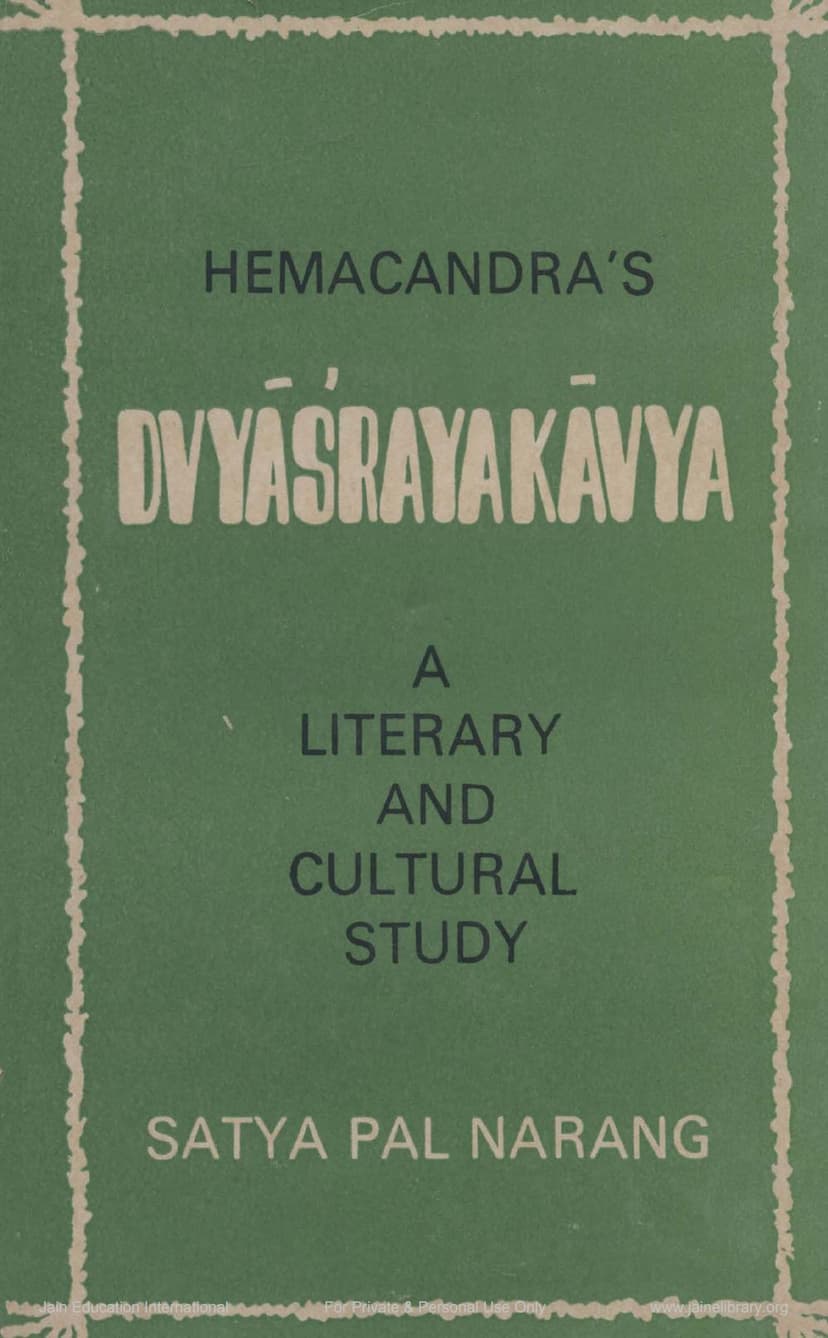Dvyasrayakavya
Added to library: September 1, 2025

Summary
Here's a comprehensive summary of the provided Jain text, "Hemacandra's Dvyasrayakavya: A Literary and Cultural Study" by Satya Pal Narang, based on the provided pages:
Book Title: Hemacandra's Dvyasrayakavya: A Literary and Cultural Study Author: Satya Pal Narang Publisher: Munshiram Manoharlal Publishers Pvt Ltd, New Delhi Publication Year: 1972
Core Focus: This book is a scholarly examination of the Dvyasrayakavya, a significant work by the Jain scholar Ācārya Hemacandra (1088-1172 AD). The study delves into the various literary, historical, grammatical, and cultural aspects of this epic poem.
Significance of Dvyasrayakavya: The Dvyasrayakavya holds a unique position in Sanskrit literature for several reasons:
- Grammatical Illustration: It serves as an elaborate illustration of Hemacandra's own comprehensive grammar, the Siddhahaimaśabdānuśāsana. It aims to explain every rule (sūtra) of the grammar with examples.
- Historical Value: It is an important historical document for understanding the history of the Caulukya dynasty of Gujarat, particularly during the 11th and 12th centuries AD.
- Cultural Study: The poem provides valuable insights into the cultural milieu of Gujarat during that period.
Key Areas of Study in the Book:
The book is structured to provide a multi-faceted analysis of Hemacandra and his Dvyasrayakavya:
- Hemacandra's Life and Personality: The study begins with an account of Hemacandra's life, his personality, his scholarly achievements, and his interactions with prominent rulers like Jayasimha and Kumārapāla. It also touches upon his role as a socio-religious reformer and his influence on the propagation of Jainism.
- Hemacandra's Works: A comprehensive overview of Hemacandra's extensive literary output is presented, categorizing his works into dictionaries, grammar treatises, metrics, rhetoric, philosophy, poems, gathas and caritas, and commentaries.
- Summary of Dvyasrayakavya: The book offers a canto-by-canto summary of the Dvyasrayakavya, outlining the historical narrative and the events described. The poem chronicles the history of the Caulukya dynasty from Mūlarāja to Kumārapāla.
- Hemacandra's Erudition: This section highlights Hemacandra's profound knowledge across various fields of Indian learning, including Vedas, Vedāngas, philosophy, Ayurveda, Dharmaśāstra, Arthaśāstra, Kāmaśāstra, music, dance, statecraft, and various sciences related to animals and jewels.
- Mythological Allusions: An analysis of the mythological references within the Dvyasrayakavya, drawn primarily from the Ramayana, Mahabharata, and Puranas.
- Dvyasrayakavya as a Mahākavya: The work evaluates the Dvyasrayakavya based on the conventional characteristics of a Mahākāvya (epic poem), examining its descriptions, sentiments, language, and style.
- Language and Style: A detailed study of Hemacandra's language and style, noting its grammatical dominance, the arrangement of verses, the use of epithets, and the vocabulary.
- Figures of Speech: An exploration of the various figures of speech employed in the poem, with a particular emphasis on the extensive use of similes, including grammatical similes.
- Characterization: An examination of the portrayal of characters, especially the royal figures of the Caulukya dynasty and their adversaries, noting the conventional characteristics and the limited innovation.
- Metrical Analysis: A canto-wise and alphabetical breakdown of the various meters used in the poem.
- Historical Evaluation: This is a crucial part of the book, assessing the historical accuracy of the Dvyasrayakavya. It identifies new information not found in contemporary sources, corroborates accurate information with other historical evidence, notes omissions, analyzes exaggerations and transformations of facts, and points out new facts introduced purely for grammatical illustration.
- Grammatical Study: A detailed analysis of Hemacandra's technique in illustrating his grammar through the poem, including his approach to sañjñās, adhikārasūtras, 'it' letters, classifications, counter-examples, synonyms, lists of words/roots, handling of multiple senses for a single root, lists of suffixes, prefixes, obsolete usages, examples of negation, elliptical examples, and optional examples.
- Geographical Data: An overview of the geographical references in the poem, including mountains, states, territorial divisions, cities, and rivers, with attempts at identification.
- Polity and Administration: Insights into the political structure, administrative system, officers, army organization, warfare, and the concept of kingship as depicted in the Dvyasrayakavya.
- Social Conditions: A study of the social fabric, including the caste system, various tribes, the position of women, marriage customs, general societal norms, food and drinks, dress, ornaments, games and amusements, music, and education.
- Economic Conditions: An examination of the economic landscape, covering agriculture, occupations, communication, debt, foreign trade, coins, and weights and measurements.
- Fauna and Flora: A catalog of the animals, birds, reptiles, flowers, creepers, and trees mentioned in the poem.
- Religious Position: An analysis of the religious landscape of Gujarat during the Caulukya period, focusing on Brahmanism (including sacrificial rituals, domestic rituals, royal rituals, worship, and other practices), Hinduism (Vaishnavism, Shaivism, Sun-worship, Mother Goddesses), Jainism (its royal patronage, concepts, ethics, and rituals), Buddhism, and the prevalent festivals, pilgrimages, beliefs, superstitions, and omens.
Overall Argument: Narang's study establishes the Dvyasrayakavya as a monumental achievement of Hemacandra, not only for its grammatical completeness and literary merit but also for its immense value as a historical and cultural source. While acknowledging the poetical embellishments and the inherent challenges of creating a grammatically illustrative epic, the book highlights Hemacandra's mastery in harmonizing diverse elements to create a work of enduring significance. The study meticulously details the poem's contents, Hemacandra's vast knowledge, and the socio-historical context it illuminates.